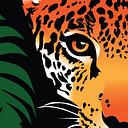People and the People of the Forest
Madison Lemelin

Humans share about 97% of our DNA with orangutans, making them one of our closest evolutionary relatives. Indeed, their name means “person of the forest” in Malay. Part of our similarities lie in cognitive brain function; we learn behavior in nearly the same way. And much like us, the development of behavior in orangutans is based on their environment. Several studies have shown that these primates can create tools to live productively and sustainably with their surroundings.
Scientists have witnessed orangutans using sticks or branches as foraging tools to reach fruit on high branches and even for protection against dangerous insects. Scientists have also seen them arrange leaves on themselves like a poncho to protect their skin from excessive sun or rain. These practices are traditions, passed down through generations. The young orangutans grow up observing the ways of their elders and when old enough, they know how to put the skills into action.

Both human and orangutan cultures depend on the creation and development of tools to survive. But unfortunately, human tools are the main threat to orangutans. Massive deforestation has taken out the critical rainforest habitat needed for these great apes survive. This occurs on such a large scale that their populations are plummeting. The International Union for Conservation of Nature lists all three orangutan species (Sumatran, Bornean and Tapanuli) as Critically Endangered.
Last year, a heartbreaking video documented the collision of our two species. In it, a lone orangutan attempted and failed to fight off a bulldozer destroying his forest. Luckily, rescuers arrived at the site to save him and bring him to shelter. But the sobering scene exemplified the stark differences between human and orangutan cultural development.
Unlike orangutans, who teach their young to grow in tandem with their environment, humans seem to reject it more and more with every generation. It’s almost as if we have stopped viewing ourselves as a part of our ecosystems. We believe that we exist outside of it, above the other species on Earth. We create our tools with this ideal in mind, veering off the path of adapting to our environment and instead creating a world for ourselves and a future where the environment has to adapt to us.
Rather than finding sustainable ways to live like our relatives, we develop the means to destroy the land for our needs. Over generations, we create bigger and stronger tools to forage for food and resources. We don’t use advanced machinery to grab fruit from branches out of reach– we use it to strip the tree of all its fruit, rip it out of the ground completely and build a whole farm in its place.
Unsustainable deforestation like this is occurring at a devastating rate, putting orangutans and other threatened species at risk of extinction. The orangutan’s fear and frustration in the video should be evidence enough for us to understand how the rest of the planet views our destruction. We need to take cues from their traditions and live as part of our ecosystems. And the most important way to do this is to use our power to protect the land needed for these species to survive.
